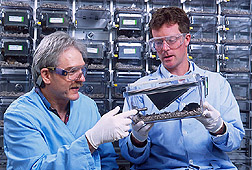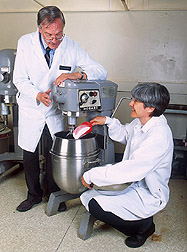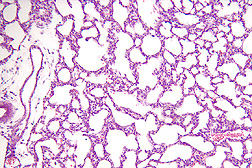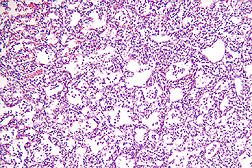Good Nutrition Benefits All—Except Viruses
|
|
|
|
It's well known that a nutritional deficiency can weaken one's defenses against microbes. But what does it do to the actual microbes?
Seven years ago, Melinda A. Beck, a virologist at the University of North Carolina, addressed this question with Agricultural Research Service nutritionist Orville A. Levander. According to Levander, who helped establish the first Recommended Dietary Allowance for selenium, Chinese scientists had noticed that a serious heart muscle inflammation attributed to selenium deficiency in their country fluctuated from season to season and year to year. This suggested that an infectious agent—possibly a virus—might be involved in the disease, which hits infants and children. So the Chinese scientists looked for and found a virus in those patients. It was a virulent strain of coxsackievirus—named after Coxsackie, New York, where it was first isolated. |
|
|
Levander teamed up with Beck's laboratory to learn how selenium deficiency and coxsackievirus interacted. They showed that a normally innocuous strain of coxsackievirus—the B3/0 strain—mutated into a heart-damaging pathogen in mice raised without any selenium added to their diets. The same thing occurred if the mouse diets lacked vitamin E, also an antioxidant. Theirs was the first report showing that a host nutritional deficiency could turn a harmless microbe into a pathogen. (See "Nutrient Deficiency Unleashes Jekyll-Hyde Virus,"Agricultural Research, August 1994, p. 14.)
Such mutations could have global implications. According to Levander, who is with ARS' Nutrient Requirements and Functions Laboratory in Beltsville, Maryland, Americans get the recommended levels of selenium in their diets. But there are pockets of selenium deficiency around the world that might be generating mutated viruses. |
|
|
Levander says, "The association between famine and epidemics has been noted throughout history. However, scientists have always focused on the effects of nutritional deficiencies on the people themselves, never on the invading pathogen."
Beck and Levander wondered whether other viruses were susceptible to changes in the oxidative environment of their host cells. Together with researchers at the Nestlé Research Center in Lausanne, Switzerland, Beck and her co-workers challenged mice with a normally mild form of influenza virus—an influenza A strain that originated in Bangkok in 1979. Like coxsackieviruses, the genome of influenza viruses is composed of RNA, rather than the more stable DNA common to bacteria and all higher organisms. |
|
|
Earlier this year, the group reported that this mild influenza strain caused more severe flu in mice raised on a selenium-deficient diet than in animals fed adequate amounts of this essential trace element. What's more, a careful look at the genome of the virus taken from the lungs of the selenium-deficient mice showed that 29 of the bases had mutated in a gene segment thought to affect virulence. By contrast, no mutations were found in the same gene segment of the virus taken from mice raised on a selenium-adequate diet. The selenium level in the deficient diet was only about 1/60 that of the adequate diet.
"Our work points to the importance of antioxidant protection against viral disease," says Beck. She speculates that increased oxidative stress in the mice—due to selenium deficiency—may have caused oxidative damage to the virus" genome, making the virus more virulent. Beck says that new strains of flu viruses arise each year because the genes tend to shuffle places, and those that code for the viral antigens are highly susceptible to mutation. "But the mutations resulting from selenium deficiency occurred in a normally stable part of the genome, making them all the more remarkable," Beck notes. More Viral Vagaries Even before the influenza studies began, Argentine microbiologist Ricardo M. Gomez, at the University of Buenos Aires, wondered if selenium deficiency would alter the effect of a variety of human viruses from unrelated families on mice hearts. He and Levander tested two other coxsackieviruses—B1 and A9—an echovirus, and a herpes simplex virus. The herpesvirus is potentially more stable, since it's a DNA virus. Ten days after exposing the animals, Gomez inspected their hearts—with mixed results. Selenium-deficient mice had more heart damage from the echovirus and the B1 coxsackievirus than the animals getting ample selenium. But it was the reverse in animals infected with the DNA herpes simplex virus: The selenium-deficient mice fared better. In the animals infected with the A9 strain of coxsackievirus, selenium status had no effect. Whether or not any of the viruses mutated under the strain of selenium deficiency is a subject for further research. These results, concludes Gomez, indicate that selenium status selectively influences the degree of virus-induced heart damage. They also demonstrate that a nutrient deficiency can affect a range of viruses and may have important implications for public health, says Levander. He adds that the phenomenon might also apply to certain animal and plant viruses. Does Competition Boost Virulence? Selenium confers its antioxidant protection mainly through two enzymes that contain it—glutathione peroxidase and thioredoxin reductase. So Levander and his co-workers wondered whether other metals that compete for the selenium site in these enzymes might worsen infection. They chose to work with the innocuous coxsackievirus B3/0 strain used in Beck's earliest studies. Levander and food scientist Paul K. South, now with the Food and Drug Administration, chose mercury—a prevalent environmental contaminant—as the competitor. The metal is known to reduce activity of both antioxidant enzymes in test animals, and it increases oxidative stress. South says 90 percent of the mice given the highest dose of mercury alone—right at their limit of tolerance—survived. But the survival rate plunged to 36 percent of the mice exposed to both mercury and the innocuous coxsackievirus. About one-third of the infected mice given the highest dose of mercury had more severe heart damage, and their hearts had higher numbers of virus. Gold is another selenium competitor, known to reduce the activity of one of the antioxidant enzymes. That prompted virologist Allen D. Smith and Levander to test two gold-containing compounds, aurothiomalate and aurothioglucose. Both are prescribed to treat rheumatoid arthritis in people. Smith saw similar pathological trends in the mice he injected with aurothiomalate but not in the animals given aurothioglucose. He says both compounds inhibited the activity of the antioxidant enzyme thioredoxin reductase to about the same extent. So aurothiomalate is producing its lethal effect through some route other than as a selenium competitor. "It's probably affecting the immune system directly," he says. Ditto for mercury. While the high dose did reduce the activity of both selenium-containing antioxidant enzymes in different organs to different degrees, "it's more likely that mercury has some effect on immune function," says South. He suspects the toxic stress of the mercury allowed the virus to replicate at a higher rate.—By Judy McBride, Agricultural Research Service Information Staff. This research is part of Human Nutrition, an ARS National Program (#107) described on the World Wide Web at http://www.nps.ars.usda.gov. Orville A. Levander and Allen D. Smith are with the USDA-ARS Nutrient Requirements and Functions Laboratory, 10300 Baltimore Ave., Bldg. 307, Beltsville, MD 20705-2350; phone (301) 504-8504 [Levander], (301) 504-8577 [Smith], fax (301) 504-9062. |
|
"Good Nutrition Benefits All—Except Viruses" was published in the September 2001 issue of Agricultural Research magazine. |
|










